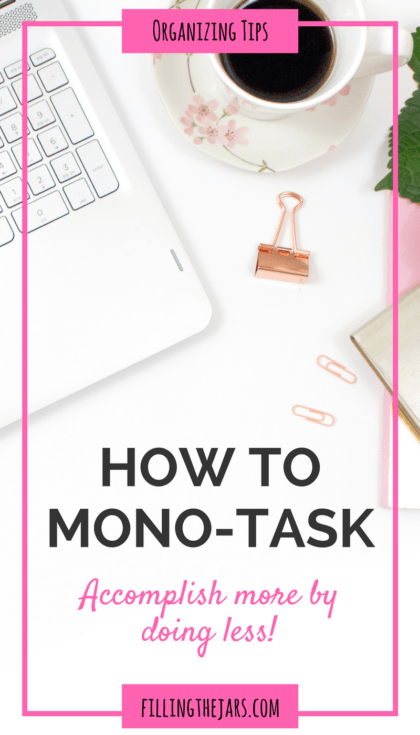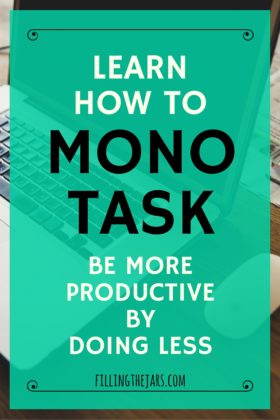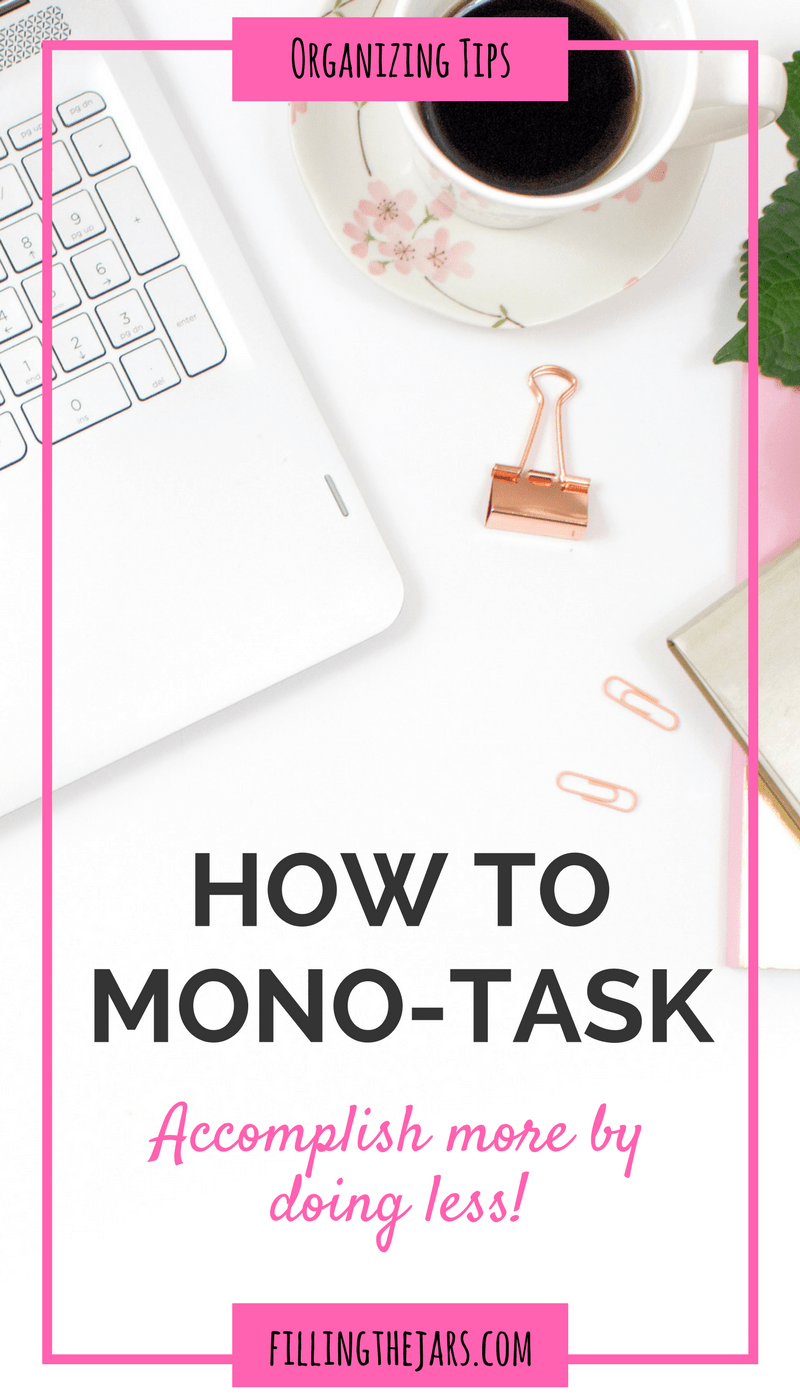Is your to-do list a mile long? Do you try to work on all of it at once in hopes that SOMETHING will be done by the end of the day?
We have been taught that multi-tasking is the way to go. Supposedly, women are good at it. We have a list in our head of the 497 daily things that need to get done and we’ve been told that we should be able to concentrate and work on all of them at the same time.
Um… nope. Let’s talk about mono-tasking and how it’s a total game-changer when it comes to productivity and powerful goals!
I don’t know about you, but most of my days go like this:
Waking up with visions of getting a million things done and being the most productive person EVER, I get up at 5:30, make the bed, hop into the shower, dress, wake up my younger son so he can shower & get ready for school, make his lunch (I know, I KNOW… he should be doing this himself; I just can’t help being an enabling mom and slapping together a pb&j every morning), check email and weather on my phone, watch the boy get on the bus at 6:25, spray down the shower, throw in a load of laundry, sigh a little happy sigh as I pour a cup of coffee, tend to the woodstove, deal with any kitchen messes that mysteriously appeared overnight (really, what’s up with that?), make sure the pets are fed…
Okay, stop!
This page contains affiliate links. If you choose to purchase through an affiliate link, I may receive a small commission at no additional cost to you. You can see my disclaimer here.
Here is Where Things Can Go Off-Track
So far this is a routine. I do the same things every morning, pretty much in the same order. If I’m working outside the home, this is the point where I get my stuff together and walk out the door. If I’m working at home, this is where my choices define whether or not I will get ANYTHING finished.
Sure, at my former job I could answer the phone, look up information on the computer, verify a visitor’s identity and press the button to let them into the building, and slap a bandage onto a student’s scraped knee all at the same time without even thinking about it. That is one form of multi-tasking, but does it work for every situation?
When I’m at home, no!
Say 5 things need to be done:
- Laundry.
- Bake cookies.
- Check and reply to email.
- Pick up around the house.
- Write an article or blog post.
If I were using the multi-tasking method, I would be trying to do all 5 things at once. Unless you’re wired for multi-tasking (most people are NOT, even if they think they are), something is going to suffer. In my case, it’s usually the cookies. As in, burned cookies. Every. Single. Time.
It doesn’t matter how many times I tell myself, “I’m just going to pop this tray into the oven and start a load of laundry. I’ll be right back.”
30 minutes later I have sorted and started a load of laundry, picked up the living room, vacuumed the hard floors (notice that was NOT on the list), checked my email, gone to the freezer to get something out for dinner for the next day (again, NOT on the list), and come back into the house to smell burned cookies.
*sigh*
Mono-Tasking to the Rescue
The other choice, and what works better for me, is mono-tasking, also known as time block organizing. I estimate how much time each task requires, and then block out time to work on ONLY THAT TASK GROUP. (Another thing I’ve learned along the way is to only bake bar cookies. One tray, in the oven for 25 minutes, DONE.)
So instead of running around the house all day trying to keep everything moving along, I set aside blocks of time for:
- Kitchen work – cooking, cleaning or tidying, prep work, making a grocery list, etc. If I’m cooking, the most important things to remember are to set a timer for anything in the oven and to not leave the room if at all possible.
- Cleaning or tidying the rest of the house. Here is where a cleaning schedule is great, but admittedly I’m not good at sticking to one. I just try to keep to a time limit for whatever needs to be done – laundry, decluttering, vacuuming, cleaning the bathroom, anything cleaning-related.
- Computer work – divided into writing and then everything else. It’s way too easy to get caught up in researching, which leads to Pinterest and new blogs and websites – talk about information overload! If you are a writer or earn money some other way online, it’s VERY important to block out time for work. (Here are some options for blocking sites you don’t want to visit while online.)
- Personal enrichment. I enjoy reading and watching television but find I have to block out time for it. Otherwise I feel like there are other more important things that need to be done. But giving myself a guilt-free half hour of reading or 43 minutes of Netflix can be exactly what my mind needs.
How to Mono-Task
If you want to see what you can accomplish, try this for 30 minutes:
1. Stop checking your email… or Facebook or Twitter or Instagram or Pinterest. I personally use the website blocker Cold Turkey on my PC to stop me from visiting certain sites when I’m writing.
2. Put your smartphone in a different room or just turn it off. Let the magic of voicemail and text messaging work for you. Those messages will be there later. Worried about missing a call from your child’s school? Then leave the phone on, but ONLY answer if it’s the school.
3. Work on that project you’ve been putting off, whatever it is. If you’ve been thinking about a DIY project, do it. A new recipe you want to try, make it. A book you can’t seem to get around to reading, start it. That article or story or blog post you’ve been meaning to write, let the words flow.
4. Set the timer if you have to so that you don’t watch the clock.
5. The most important thing to remember: Do nothing else. Don’t get up to switch the laundry. Don’t make that one phone call or send the quick email to your child’s teacher. Don’t head into the kitchen for a snack. Don’t start a list of great movies you would like to watch.
6. When 30 minutes is up, take a break and evaluate what you’ve done. I have a feeling you will find the same thing I have – you get more done in 30 minutes of concentrated effort than an hour of running in circles around the house trying to get everything done at the same time.
If you are writing or working on a project, your mind will not be distracted and you won’t spend half your day trying to “get back into the groove” because you keep getting up to do something else.
Get more done in 30 minutes of concentrated effort than an hour of running in circles. Click To TweetHow to Plan a Full Day Using the Mono-Tasking Method
- Make your To Do list.
- Group tasks.
- Estimate time for each group.
- Divide time into blocks.
- Remember to plan time for breaks and lunch!
You can write everything out on a piece of paper until you get a schedule figured out that works for you. Here’s my free printable daily planning page.
Sometimes I like to use a spreadsheet because I can move work blocks around and then print it out to have a visual if I need it that day.
You can also use the calendar app on your phone or Google calendar. One nice thing about those options is the ability to set reminders to alert you at times you have chosen.
Here’s a great video for creating those longer blocks of similar tasks:
Real Life
Not every day will lend itself to mono-tasking. Especially if you have little ones – I know, I’ve been there!
But for those times of the day when you can choose how to work on the to do list, try mono-tasking. Be sure to leave a comment and let me know how it works for you!

Click on the image above to Pin or Tweet.




I needed to read this TODAY!! Thank you!! Pinned and tweeted. 🙂
I was feeling guilty because I’ve been behind on blog stuff: typing up my posts, comments, and visits, but 2 of my babies have been sick, which means my focus has been on them and their health; now I’m behind. Tomorrow, I will implement the 30 minute mono tasking, and yes I’ll put away my phone!
Thanks for such wonderful advice!!
XOXO
I hope your little ones are feeling better soon! Keeping them well is definitely our #1 focus as moms! Let me know how things go for you when you try to work without distractions.
In some cases, such as being pregnant for the 3rd time, block out nap time for yourself too! I know I feel better if I lay down and close my eyes for 30 minutes or so every now and then if I have a ton of work to get done.
Great suggestion, Heather! 🙂
I’m looking forward to trying this. Thanks for posting.